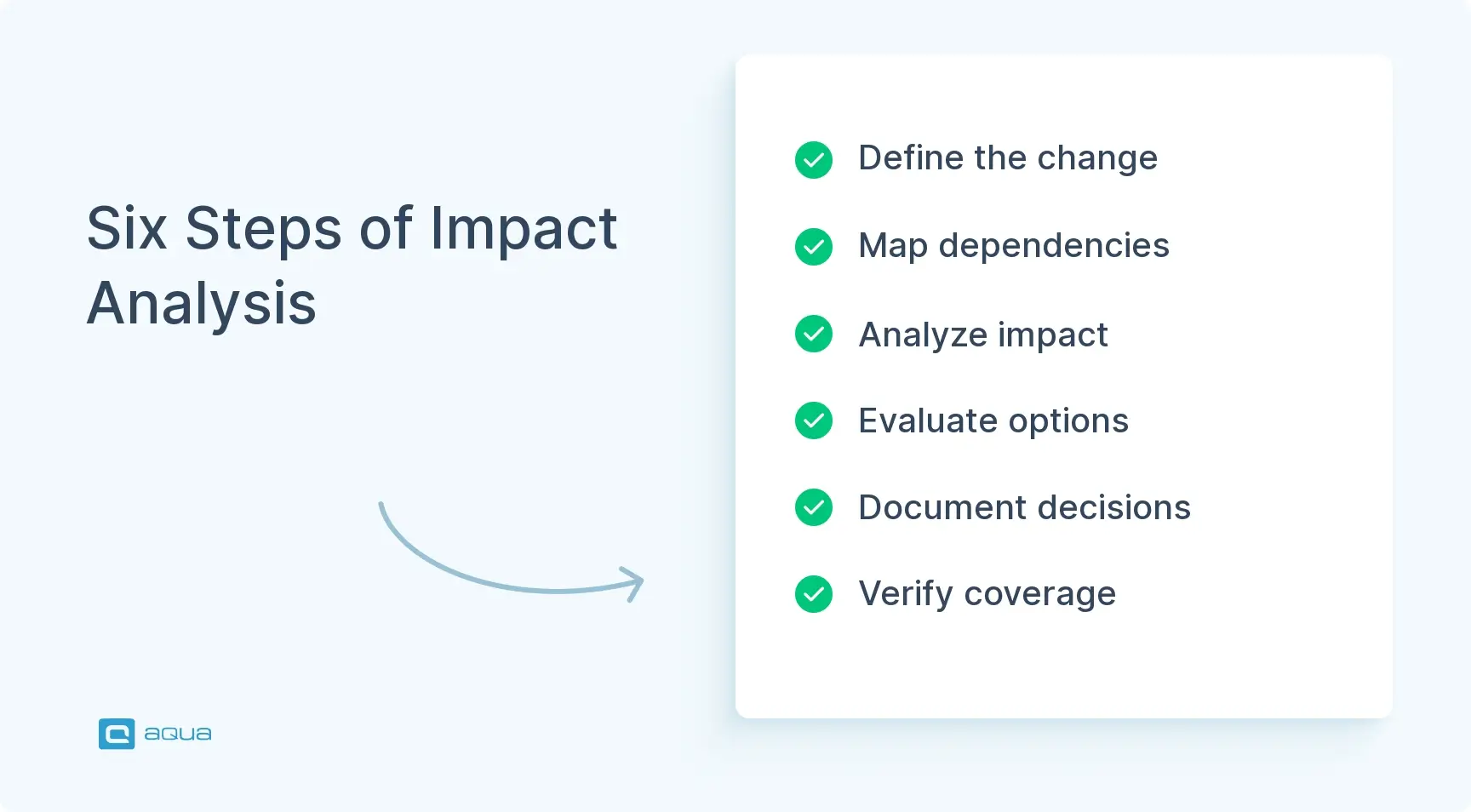Key takeaways
- Requirements Impact Analysis systematically assesses how any requirement change affects scope, design, interfaces, verification plans, timelines, budgets, risks, and compliance across a project.
- Impact analysis requires end-to-end traceability, linking requirements to design, code, tests, risks, and regulations to visualize the blast radius of any change instantly.
- The six-step RIA process includes defining the change, mapping dependencies through traceability, analyzing impact dimensions, evaluating options, documenting decisions, and verifying coverage.
- Organizations using structured impact analysis report fewer surprises, more predictable timelines, and stronger audit readiness without sacrificing development speed.
Even a “small change” request might cascade through your codebase, break test cases, and delay your sprint by weeks. Learn how requirements impact analysis influences change requests, transforming them into something your team can manage 👇
What is Requirements Impact Analysis?
Requirements impact analysis (RIA) answers the question “What breaks if we change this?” This structured assessment traces how any proposed or actual modification to requirements will affect everything else in your orbit: scope, design, interfaces, verification plans, timelines, budgets, risks, compliance obligations, and stakeholder expectations. Standards like ISO/IEC/IEEE 29148 position impact analysis as a core piece of requirements management and change control. It runs on one critical ingredient: traceability across your project artifacts.
RIA affects working processes in QA teams. When you have solid end-to-end traceability, i.e., requirements linked to design, design linked to code, code linked to tests, tests linked back to risks and regulations, you can see the impact radius of any change instantly. This way, you have evidence, which helps you make better decisions, avoid costly rework cycles, and keep your verification coverage intact even as requirements shift.
Requirements impact analysis delivers the following tangible benefits:
- Better decisions with fewer surprises: You get an evidence-based view of consequences before approving a change. Fewer “oh crap” moments three sprints later.
- Regulatory and audit readiness: In regulated environments (medical devices, automotive, aerospace), RIA plus traceability shows you have control over change. You can prove how tests, risks, and compliance all tie together.
- Predictable timelines and budgets: Quantify schedule, cost, and risk impacts. Your plans stay credible and you protect critical paths instead of blowing past them.
- Quality at speed: Good traceability accelerates safe changes and reduces defect leakage downstream.
In short, requirements impact analysis turns change from chaos into something manageable. When working in agile sprints or regulated releases, that control makes the difference between shipping on time and scrambling to explain delays.
The Importance of Change Impact Analysis
Requirements impact analysis helps to make decision-making more proactive. Instead of discovering problems after deployment, you spot them during planning when adjustments cost minutes instead of weeks. The analysis creates a feedback loop between change requests and their real-world consequences across your system architecture, test suite, and delivery commitments.
- It quantifies scope creep before it happens. When stakeholders propose “one small change,” your traceability model shows them that the actual blast radius is much bigger. That visibility transforms vague requests into informed trade-off discussions.
- It protects verification coverage. In regulated development, every requirement must trace to verification activities. When requirements change without proper analysis, you end up with orphaned tests that verify obsolete behavior and new functionality with zero test coverage. Effective requirements impact analysis prevents that gap by flagging exactly which test cases need updates and which new ones you’ll need to write.
- It builds institutional memory. Your documented impact analyses become a searchable knowledge base showing why certain decisions were made, which alternatives were considered, and what dependencies exist. When team members leave or new people join, this context prevents repeated mistakes and speeds up onboarding.
In short, change impact analysis separates controlled iteration from costly chaos. Understanding the full ripple effect before approving a change protects your scope, budget, and credibility and saves your team from unnecessary stress later.
In development, managing the full impact of requirement changes affects quality and predictability. Without the right tools, tracing these impacts can quickly become an overwhelming manual process. That’s where aqua cloud, an AI-powered requirement and test management system, truly stands out. Using aqua’s domain-trained AI Copilot, you can generate test cases and requirements based on your documentation, text, visuals, or voice notes. With end-to-end visual traceability mapping, aqua reveals the relationships between requirements, test cases, and defects instantly. When requirements change, aqua’s dependency graphs and linking capabilities automatically identify which test assets are affected. Native aqua integrations with Jira and CI/CD pipelines ensure collaboration across your workflow. Combined with enterprise-grade reliability and professional support, aqua gives you both speed and confidence. Due to aqua, impact analysis becomes a one-click operation instead of a complicated manual procedure.
Save up to 97% of your impact analysis time with aqua's intelligent traceability system
The Steps in Conducting Requirements Impact Analysis
Are you already sold on the idea that requirements impact analysis matters? Now for the practical part. Here’s a field-tested, step-by-step process you can plug into your workflow easily, whether you run Agile sprints or waterfall phases.

1. Define and Clarify the Change
Start by clearly defining what’s changing and why. Avoid vague requests like “make the UI more intuitive.” Describe the modification in specific, testable terms. Which requirement or baseline item is affected? What triggered the change: e.g., a stakeholder request, a failed test, or a regulatory update? Link it back to the correct baseline ID so everyone works from the same version of truth. If a request lacks enough detail to trace, send it back for clarification before wasting time on guesswork.
This step sets the stage for everything else. A clear, well-defined change makes traceability easier, scoping faster, and decisions cleaner.
This is exactly where Quality Focused resources come into play. People dedicated to identifying risk, gaps and measuring the quality of the application/feature/change.
2. Identify Affected Requirements
Next, trace the change through your project in both directions. Start upstream to check parent requirements, stakeholder goals, and related standards. Then move downstream to find dependent design elements, code modules, test cases, or risk controls. Modern tools visualize this instantly through graphs or matrices: you click one requirement and see everything it touches.
If your traceability is weak, you’re relying on assumptions. Mature teams ensure each requirement connects to at least one verification method and, where needed, a safety or compliance control. Tools like aqua cloud, an AI-driven requirement management platform, make it easy to map these links and generate “impact reports” in seconds instead of searching through spreadsheets.
The output is a clear roster of every artifact touched by the change. This becomes your checklist for the next step.
3. Analyze Impact Dimensions
Now, examine what each affected item means in practice. Look beyond the code to the broader system. Break the impact into dimensions:
- Technical and design changes: What components, interfaces, or algorithms need rework?
- Verification gaps: Which tests need to be added, modified, or retired? Are there new edge cases?
- Risk deltas: Does this change introduce new hazards or mitigate existing ones? Re-score severity, occurrence, and detection if you’re in a safety-critical domain.
- Compliance implications: Does the change affect regulatory mappings? Will it trigger re-validation or audit scrutiny?
- Schedule and milestones: What tasks get added to the backlog? Does this push out a release date or delay a gate?
- Cost and effort: What’s the estimated hours, budget impact, or resource contention?
Document this systematically, ideally in a structured impact brief. The goal is to replace gut-feel estimates with data-driven projections so decision-makers work with facts instead of guesswork.
4. Evaluate Options and Present Trade-Offs
Rarely is there only one way to address a change request. Package your findings as options. Typically: (A) accept the change as proposed with full impact quantified, (B) alternative implementation that achieves the same goal with lower blast radius (for example, scope the change to fewer subsystems or defer non-critical updates), (C) defer until a future release when dependencies align better, or (D) reject if the cost-benefit doesn’t close. Include quantified estimates for each: schedule delta, effort in person-hours, risk treatment plans, and any conditions (like vendor approvals or tooling upgrades).
This is where analysis turns into decision support. Present trade-offs clearly: “Option A delivers full functionality but pushes Milestone 2 by two weeks and requires 40 hours of regression testing. Option B limits the change to Subsystem X, ships on time, but defers enhanced error handling to Release 2.1.” Decision authorities (Change Control Boards, product owners, or release managers) can then weigh business value against project constraints and make an informed call rather than rubber-stamping requests blindly.
5. Obtain Approval or Rejection from Stakeholders
With your analysis complete, bring it to the right decision-makers. In regulated industries, that’s usually a Change Control Board (CCB) including engineering, QA, and compliance representatives. In agile teams, it might be the product owner and tech lead. Ensure every decision is recorded, i.e., who approved it, which option they chose, and what conditions apply.
Besides, it’s important to classify changes by risk to streamline approvals: low-risk updates can move fast, while high-impact or safety-critical ones need formal review. Tools like Jira Service Management already support such tiered workflows. The goal is consistency, so no baselined change should bypass review, even under deadline pressure.
6. Implement and Verify Changes
Once approved, update all affected artifacts: requirements, design specs, interface documents, test cases, risk registers, compliance mappings. Re-establish the baseline with refreshed traceability links. Execute the new or modified tests, run regression suites on impacted areas, and confirm that coverage hasn’t degraded (no dangling requirements without verification, no orphaned test cases). If the change altered hazard controls or safety requirements, update hazard analyses and make sure mitigations remain effective.
After implementation, perform a coverage check: are all modified requirements still traced to passing tests? Are risk treatments verified? Did any links break or become stale? Tools like ReqView and Polarion offer automated gap detection. They flag items that lost their verification trail or haven’t been re-tested post-change. Finally, log lessons learned. Was the estimate accurate? Did any surprise dependencies surface? Could traceability quality improve? Feed that intelligence back into your process. This closes the loop so each cycle sharpens your impact analysis muscle.
Tools and Techniques for Impact Analysis
Manual impact analysis doesn’t scale. Tracking dependencies by hand quickly turns messy and unreliable. The right tools make traceability seamless, automate evidence collection, and reveal affected areas in seconds instead of hours. Below is an overview of the most effective solutions used to manage change efficiently.
Optimal choice for all team sizes
- aqua cloud: Purpose-built requirement and test management platform for both small teams and enterprises that need requirements impact analysis. aqua provides visual traceability without the complexity of traditional ALM platforms. This all-in-one solution connects requirements, test cases, and defects in a single view. When requirements change, dependency graphs instantly show which tests are affected. aqua scales from agile startups to regulated enterprises, delivering enterprise-grade traceability with the speed and usability modern teams expect. Unlike heavyweight tools that require complex configuration, aqua gets you up and running in days.
Established options for larger organizations:
- IBM DOORS and DOORS Next: Heavyweights offering mature linking and navigation. Suitable for impact analysis across large, complex modules.
- PTC Codebeamer: End-to-end application lifecycle management with regulated-industry workflows. It’s popular with teams needing requirements-to-test traceability under FDA or ISO scrutiny.
Lighter-weight options for smaller teams:
- ReqView: Affordable, ReqIF-friendly tool providing clean RTM and impact/coverage analysis features, with optional Neo4j integration for graph-based traceability queries.
- Visure Requirements: Configurable ALM with impact analysis reports, friendly for mid-sized product teams.
Jira ecosystem:*
Important note: Jira and its ecosystem are not a direct substitute for other RIA-centered solutions. Lots of companies find it optimal to use Jira with a dedicated requirement management tool, like aqua platform.
- Core Jira: An issue tracker that alone won’t provide the bidirectional requirements-to-test traceability needed for robust change impact.
- Requirements & Test Management (RTM) for Jira: Add-ons and plugins that provide relation trees and impact views to augment Jira’s capabilities.
- Jira Service Management: Supports change categories and workflows for operational change control, complementing (but not replacing) requirements-level RIA.
Techniques that work across any tool:
Using our experience, the aqua cloud team has gathered some of the best techniques for requirements impact analysis. Here’s the list:
- End-to-end traceability models: Define what artifacts link to what (stakeholder needs ↔ system requirements ↔ design ↔ code ↔ tests ↔ risks ↔ regulations) and enforce it in your tool. Matrix and graph views are both valuable. Use whichever helps your team visualize dependencies faster.
- Change categorization: Not all changes carry the same risk. Categorize them (standard, normal, emergency) to scale your analysis effort and approval path accordingly. Atlassian’s ITSM practices cover this well.
- What-if views and dependency graphs: Auto-generate reports that show “if I change this requirement, here’s every parent, child, and sibling that’s affected.” This should be a one-click operation, not a manual treasure hunt.
- Risk-aware RIA: Link changes to hazard analysis and control measures. Re-score severity, occurrence, and detection where relevant, especially in MedTech or automotive contexts where safety matters most.
- Coverage and gap checks: Highlight untested or unchanged areas that should be retested. Flag missing traceability links before they become audit findings.
Pick a tool that fits your domain, budget, and team size, but don’t compromise on traceability. If your current setup can’t show you upstream and downstream impacts in under a minute, upgrade or augment it.
Software keeps changing, so our testing approach needs to evolve too. I've learned that yesterday's critical tests might not matter much today. Do you guys take time to reassess your test priorities? Sometimes we realize we're wasting time on areas that rarely cause problems while missing newer risks.
Case Studies: Successful Impact Analysis in Action
Here are examples of companies that implemented requirements impact analysis and saw real results.
Össur (Medical Devices)
This Icelandic prosthetics company faced the classic regulated-product challenge: how do you move fast without breaking compliance or quality? They adopted a requirement impact analysis solution to build end-to-end traceability through design, verification, and risk management. Results: Improved development speed and efficiency, driven by better impact analysis. When a change request came in, they could see instantly which tests, hazards, and regulatory mappings were affected. They scoped the work accurately and executed without surprises.
Medtronic Neuromodulation
Medtronic’s neuromodulation division was struggling with legacy tools that turned every change into a multi-week ordeal. To fix the issue, they changed workflows using an ALM solution that provided compliant requirements-to-test traceability. This sped things up and reduced rework cycles. It also gave stakeholders confidence that changes were properly analyzed and controlled. For a company operating under FDA scrutiny, that confidence translates directly into audit readiness and market velocity.
Bigfoot Biomedical
A startup developing an automated insulin delivery system needed to prove to regulators that they had disciplined change control and traceability from day one. They implemented a solution to support compliant requirements-to-test workflows. This way, they managed to avoid the common startup trap of accruing compliance debt. At the end of the day, their new workflow enabled them to demonstrate to the FDA that every requirement change was tracked, analyzed, and properly controlled. That’s how Bigfoot Biomedical established credibility and accelerated its path to market.
These cases share a common approach: they treated requirements management and impact analysis as infrastructure, not overhead. The big idea here is that RIA can be a notable competitive advantage. aqua brings this same requirement engineering capability into your requirement management workflow. Visual traceability with aqua reveals how requirements, test cases, and defects connect. When a requirement changes, aqua’s dependency graphs show you exactly which test assets need attention. With aqua, you don’t need to piece together multiple tools or sacrifice speed for compliance. You get both in one unified solution.
Boost your project’s requirement management effectiveness by 70%
Best Practices for Effective Impact Analysis
You’ve seen how requirements impact analysis works and which tools can support it. Now it’s time for the habits that separate teams just ticking boxes from those doing real, value-driven analysis:
Align with standards: Start with proven frameworks. ISO/IEC/IEEE 29148 and the IIBA’s BABOK both provide solid foundations for managing requirement changes. Adapt their guidance to your domain instead of reinventing the process.
Make traceability effortless: Pre-configure link types in your tool and provide one-click “Show Impact” views (matrix, graph, or both). If your team has to manually hunt for dependencies, they won’t do it consistently. Train everyone to navigate traceability as naturally as they navigate your codebase.
Right-size the ceremony: Match the depth of analysis to the level of risk. A typo fix? Quick check and move on. A change to a safety-critical algorithm? Full RIA, cross-team review, and formal approval. Apply rigor where it matters most.
Automate evidence collection: Your tool should auto-generate lists of linked tests, risks, design elements, and compliance mappings. It should flag missing links and highlight untested areas. If you’re still copying artifact IDs into spreadsheets, you’re doing it wrong.
Close the loop: After implementation, confirm that coverage is complete, tests pass, and all compliance mappings are current. Re-baseline your artifacts and archive the analysis for future audits. This turns RIA into a continuous improvement cycle.
Build a traceability model and stick to it: Clearly outline which artifact types exist and how they link (e.g., every system requirement traces to at least one verification method and test case). Keep it simple, consistent, and enforced.
Encourage ownership and accountability: Assign someone (a BA, a QA lead, a requirements engineer) to shepherd each change through the RIA process. Don’t let it become “somebody else’s problem” that falls through the cracks.
Requirements impact analysis transforms change from a source of anxiety into something you can confidently manage. But a robust RIA process requires the right tooling to make traceability effortless and impact assessment immediate. This is where aqua cloud, a comprehensive, AI-driven requirement management solution, stands out as a game-changerger. Unlike basic issue trackers, aqua provides bidirectional traceability across your entire testing ecosystem. Aqua’s domain-trained AI Copilot takes this further. When requirements change, it can generate updated test cases that understand your project’s specific context, terminology, and compliance needs. The intelligence is grounded in your actual project documentation, making every suggestion relevant and implementation-ready. With direct Jira integration, your development and QA teams stay synchronized. This eliminates the fraction that often leads to missed impacts and unexpected breaks. With aqua, you can accurately scope the work and maintain complete test coverage while applying the best requirements impact analysis principles.
Save up to 80% time on requirement management with aqua's AI intelligence
Conclusion
As you could note, requirements impact analysis is intended to give you the clarity and confidence to move fast without breaking your development and testing processes. When you have solid traceability, then change management is no longer a source of anxiety. It becomes something you can plan around instead. The core principles of software impact analysis stay the same whether you work in a regulated industry where audit trails are required or in a fast-moving agile shop where every sprint brings new feature requests. The teams that apply the practices well, like Össur, Medtronic, and Bigfoot Biomedical, treat RIA as infrastructure rather than overhard, and they get the rewards in predictable timelines and stakeholder trust. You can do the same.

















